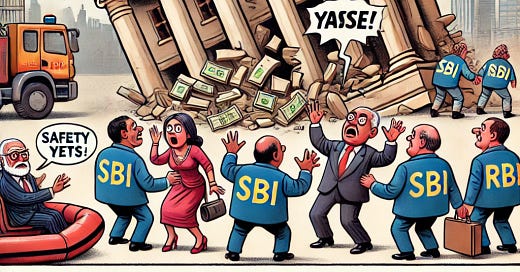The Yes Bank Crisis (2020)
Case Study 3 | Lessons From The Market | How reckless growth, poor governance, and a liquidity crisis led to the downfall of a banking giant
In this Newsletter:
The Rise and Fall of Yes Bank – How an aggressive growth strategy and poor risk management led to a catastrophic collapse.
The Role of Regulatory Warnings – Why early red flags from the RBI were ignored and how investors could have spotted the risks.
Key Lessons for Investors – The critical takeaways from the Yes Bank crisis to avoid similar pitfalls in the future.
Note: The purpose of the "Lessons from the Market" section under “The Value Investor's Lab” is to help readers understand the stories behind the stock market’s most remarkable events. Readers are encouraged to research any technical terms or concepts introduced in this case study, if necessary.
Introduction:
The Yes Bank crisis of 2020 serves as a stark reminder of how aggressive growth, poor risk management and regulatory complacency can lead to the downfall of even a high-profile financial institution. Once the fourth-largest private bank in India, Yes Bank’s collapse led to a government-backed bailout and significant losses for shareholders. This case study explores the key events, underlying causes, and the lessons value investors can learn from this crisis.
Background and Rise of Yes Bank:
Founded in 2004 by Rana Kapoor and Ashok Kapur, Yes Bank quickly positioned itself as a high-growth, tech-savvy private lender. Under Rana Kapoor’s leadership, the bank aggressively expanded its loan book, boasting impressive profitability and growth rates. Between 2010 and 2017, Yes Bank’s loan book grew at a CAGR of over 30%, and its stock price surged more than 15 times from its IPO price.
Investors and analysts viewed Yes Bank as a shining star among private sector banks. However, beneath the surface, its risk management policies were deteriorating, and the bank’s exposure to stressed corporate borrowers was increasing.
The Downfall: What Went Wrong?
1. Aggressive Lending and Poor Risk Management :
Yes Bank followed a strategy of lending to businesses that other banks considered too risky. It had high exposure to highly leveraged corporate borrowers, including IL&FS, DHFL, Jet Airways, Reliance ADAG, Cox & Kings, and Essel Group—all of which later defaulted.
While Yes Bank reported low NPAs, the Reserve Bank of India (RBI) flagged discrepancies in the bank’s asset quality reports as early as 2015. Instead of addressing the issues, Yes Bank continued to underreport bad loans.
2. Governance and Leadership Issues :
Rana Kapoor had excessive control over the bank’s operations, and corporate governance standards were weak. The RBI refused to extend his tenure as CEO in 2018, signalling governance concerns. Despite this, Kapoor continued to exert influence over the bank’s decisions.
In 2019, reports emerged about Kapoor's questionable loan practices, including lending to companies that had personal ties to him. These governance failures eroded investor confidence.
3. Liquidity Crunch and Bank Run :
By late 2019, rating agencies started downgrading Yes Bank’s debt due to concerns over its exposure to stressed assets. Depositors began withdrawing their funds, leading to a liquidity crisis.
In early 2020, Yes Bank was unable to raise fresh capital, and its financial condition deteriorated rapidly. On March 5, 2020, the RBI placed Yes Bank under a moratorium, capping withdrawals at ₹50,000 per account and superseding its board. The crisis created panic in the banking sector, and Yes Bank’s stock crashed nearly 85% in a year.
4. Government and RBI Intervention :
To prevent a systemic banking crisis, the RBI and the Government of India orchestrated a rescue plan. The State Bank of India (SBI) led a ₹10,000 crore bailout, acquiring a 49% stake in Yes Bank. Other financial institutions, including HDFC, ICICI Bank, and Axis Bank, also participated in the capital infusion.
A new management team was brought in, and Yes Bank was gradually stabilized. However, existing shareholders, particularly retail investors, suffered massive losses.
Lessons for Value Investors:
1. Growth Without Risk Control is Dangerous: Yes Bank's rapid expansion was fueled by reckless lending. Investors should scrutinize a company's loan book quality rather than just its growth numbers. High growth at the cost of risk management is a red flag.
2. Strong Corporate Governance is Non-Negotiable: Rana Kapoor’s unchecked control led to mismanagement and fraud. Investors must evaluate promoter integrity, board independence, and governance practices before investing.
3. The Importance of Regulatory Warnings: The RBI had flagged Yes Bank’s asset quality issues multiple times, but many investors ignored these warnings. Regulatory concerns should always be taken seriously.
4. Liquidity Matters More Than Profits: Even a profitable company can fail if it runs out of liquidity. Yes Bank collapsed because it couldn’t meet withdrawal demands. Investors should look beyond earnings and analyze liquidity coverage ratios, asset-liability mismatches, and capital adequacy ratios.
5. Blind Faith in Large Institutions Can Be Costly: Many retail investors assumed Yes Bank was “too big to fail.” While SBI’s bailout saved depositors, equity shareholders suffered heavy losses. Never assume a company is invincible, no matter how big or prestigious it appears.
The Yes Bank crisis is a cautionary tale about aggressive lending, governance failures, and the illusion of perpetual growth. Investors must stay vigilant, conduct thorough due diligence, and pay close attention to red flags before investing in financial institutions.
For value investors, the key takeaway is clear: Risk management and governance matter as much as growth and profitability. Avoiding disasters like Yes Bank requires not just looking at financial statements but understanding the quality of a company's decision-making and risk exposure.
⚠️Disclaimer:The Value Investor's Lab is dedicated to providing educational content to help readers understand the principles of value investing. We do not promote or recommend specific companies, securities, or investment strategies. Readers are encouraged to consult registered and approved financial advisors for personalized investment decisions.






